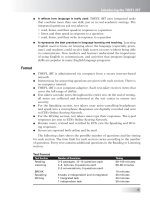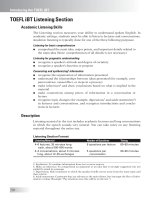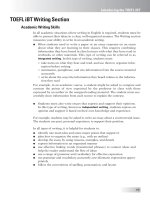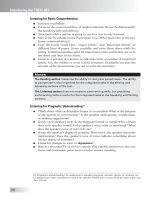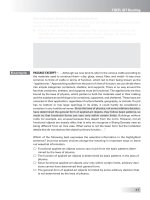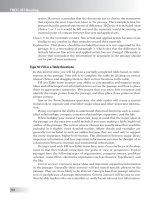The official guide to the toefl ibt third edition part 38 docx
Bạn đang xem bản rút gọn của tài liệu. Xem và tải ngay bản đầy đủ của tài liệu tại đây (80.91 KB, 7 trang )
250
TOEFL iBT Practice Test 1
GEOLOGY AND LANDSCAPE
Most people consider the landscape to be unchanging, but Earth is a dynamic body,
and its surface is continually altering—slowly on the human time scale, but relatively
rapidly when compared to the great age of Earth (about 4,500 billion years). There are
two principal influences that shape the terrain: constructive processes such as uplift,
which create new landscape features, and destructive forces such as erosion, which
gradually wear away exposed landforms.
Hills and mountains are often regarded as the epitome of permanence, success-
fully resisting the destructive forces of nature, but in fact they tend to be relatively
short-lived in geological terms. As a general rule, the higher a mountain is, the more
recently it was formed; for example, the high mountains of the Himalayas are only
about 50 million years old. Lower mountains tend to be older, and are often the
eroded relics of much higher mountain chains. About 400 million years ago, when the
present-day continents of North America and Europe were joined, the Caledonian
mountain chain was the same size as the modern Himalayas. Today, however, the
relics of the Caledonian orogeny (mountain-building period) exist as the compara-
tively low mountains of Greenland, the northern Appalachians in the United States,
the Scottish Highlands, and the Norwegian coastal plateau.
The Earth’s crust is thought to be divided into huge, movable segments, called
plates, which float on a soft plastic layer of rock. Some mountains were formed as a
result of these plates crashing into each other and forcing up the rock at the plate mar-
gins. In this process, sedimentary rocks that originally formed on the seabed may be
folded upwards to altitudes of more than 26,000 feet. Other mountains may be raised
by earthquakes, which fracture the Earth’s crust and can displace enough rock to pro-
duce block mountains. A third type of mountain may be formed as a result of volcanic
activity which occurs in regions of active fold mountain belts, such as in the Cascade
Range of western North America. The Cascades are made up of lavas and volcanic
materials. Many of the peaks are extinct volcanoes.
Whatever the reason for mountain formation, as soon as land rises above sea
level it is subjected to destructive forces. The exposed rocks are attacked by the vari-
ous weather processes and gradually broken down into fragments, which are then
carried away and later deposited as sediments. Thus, any landscape represents only
a temporary stage in the continuous battle between the forces of uplift and those of
erosion.
The weather, in its many forms, is the main agent of erosion. Rain washes away
loose soil and penetrates cracks in the rocks. Carbon dioxide in the air reacts with the
rainwater, forming a weak acid (carbonic acid) that may chemically attack the rocks.
The rain seeps underground and the water may reappear later as springs. These
springs are the sources of streams and rivers, which cut through the rocks and carry
away debris from the mountains to the lowlands.
Under very cold conditions, rocks can be shattered by ice and frost. Glaciers may
form in permanently cold areas, and these slowly moving masses of ice cut out val-
leys, carrying with them huge quantities of eroded rock debris. In dry areas the wind
is the principal agent of erosion. It carries fine particles of sand, which bombard
exposed rock surfaces, thereby wearing them into yet more sand. Even living things
contribute to the formation of landscapes. Tree roots force their way into cracks in
rocks and, in so doing, speed their splitting. In contrast, the roots of grasses and other
small plants may help to hold loose soil fragments together, thereby helping to pre-
vent erosion by the wind.
Most people consider the landscape to be unchanging, but Earth is a dynamic body,
and its surface is continually altering—slowly on the human time scale, but relatively
rapidly when compared to the great age of Earth (about 4,500 billion years). There are
two principal influences that shape the terrain: constructive processes such as uplift,
which create new landscape features, and destructive forces such as erosion, which
gradually wear away exposed landforms.
Directions
: Mark your answer by filling in the oval next to your choice.
1. According to paragraph 1, which of the following statements is true of changes in
Earth’s landscape?
ɕ
They occur more often by uplift than by erosion.
ɕ
They occur only at special times.
ɕ
They occur less frequently now than they once did.
ɕ
They occur quickly in geological terms.
2. The word relatively in the passage is closest in meaning to
ɕ
unusually
ɕ
comparatively
ɕ
occasionally
ɕ
naturally
251
Reading
GO ON TO THE NEXT PAGE g
P
A
R
A
G
R
A
P
H
1
Hills and mountains are often regarded as the epitome of permanence, successfully
resisting the destructive forces of nature, but in fact they tend to be relatively short-
lived in geological terms. As a general rule, the higher a mountain is, the more re-
cently it was formed; for example, the high mountains of the Himalayas are only
about 50 million years old. Lower mountains tend to be older, and are often the
eroded relics of much higher mountain chains. About 400 million years ago, when the
present-day continents of North America and Europe were joined, the Caledonian
mountain chain was the same size as the modern Himalayas. Today, however, the
relics of the Caledonian orogeny (mountain-building period) exist as the compara-
tively low mountains of Greenland, the northern Appalachians in the United States,
the Scottish Highlands, and the Norwegian coastal plateau.
3. Which of the following can be inferred from paragraph 2 about the mountains
of the Himalayas?
ɕ
Their current height is not an indication of their age.
ɕ
At present, they are much higher than the mountains of the Caledonian range.
ɕ
They were a uniform height about 400 million years ago.
ɕ
They are not as high as the Caledonian mountains were 400 million years ago.
4. The word relics in the passage is closest in meaning to
ɕ
resemblances
ɕ
regions
ɕ
remains
ɕ
restorations
The Earth’s crust is thought to be divided into huge, movable segments, called plates,
which float on a soft plastic layer of rock. Some mountains were formed as a result of
these plates crashing into each other and forcing up the rock at the plate margins. In
this process, sedimentary rocks that originally formed on the seabed may be folded
upwards to altitudes of more than 26,000 feet. Other mountains may be raised by
earthquakes, which fracture the Earth’s crust and can displace enough rock to produce
block mountains. A third type of mountain may be formed as a result of volcanic ac-
tivity which occurs in regions of active fold mountain belts, such as in the Cascade
Range of western North America. The Cascades are made up of lavas and volcanic
materials. Many of the peaks are extinct volcanoes.
5. According to paragraph 3, one cause of mountain formation is the
ɕ
effect of climatic change on sea level
ɕ
slowing down of volcanic activity
ɕ
force of Earth’s crustal plates hitting each other
ɕ
replacement of sedimentary rock with volcanic rock
252
TOEFL iBT Practice Test 1
P
A
R
A
G
R
A
P
H
2
P
A
R
A
G
R
A
P
H
3
The weather, in its many forms, is the main agent of erosion. Rain washes away loose
soil and penetrates cracks in the rocks. Carbon dioxide in the air reacts with the rain-
water, forming a weak acid (carbonic acid) that may chemically attack the rocks. The
rain seeps underground and the water may reappear later as springs. These springs
are the sources of streams and rivers, which cut through the rocks and carry away de-
bris from the mountains to the lowlands.
6. Why does the author mention Carbon dioxide in the passage?
ɕ
To explain the origin of a chemical that can erode rocks
ɕ
To contrast carbon dioxide with carbonic acid
ɕ
To give an example of how rainwater penetrates soil
ɕ
To argue for the desirability of preventing erosion
7. The word seeps in the passage is closest in meaning to
ɕ
dries gradually
ɕ
flows slowly
ɕ
freezes quickly
ɕ
warms slightly
Under very cold conditions, rocks can be shattered by ice and frost. Glaciers may form
in permanently cold areas, and these slowly moving masses of ice cut out valleys, car-
rying with them huge quantities of eroded rock debris. In dry areas the wind is the
principal agent of erosion. It carries fine particles of sand, which bombard exposed
rock surfaces, thereby wearing them into yet more sand. Even living things contribute
to the formation of landscapes. Tree roots force their way into cracks in rocks and, in
so doing, speed their splitting. In contrast, the roots of grasses and other small plants
may help to hold loose soil fragments together, thereby helping to prevent erosion by
the wind.
8. The word them in the passage refers to
ɕ
cold areas
ɕ
masses of ice
ɕ
valleys
ɕ
rock debris
253
Reading
GO ON TO THE NEXT PAGE g
P
A
R
A
G
R
A
P
H
5
P
A
R
A
G
R
A
P
H
6
Hills and mountains are often regarded as the epitome of permanence, successfully
resisting the destructive forces of nature, but in fact they tend to be relatively short-
lived in geological terms. As a general rule, the higher a mountain is, the more re-
cently it was formed; for example, the high mountains of the Himalayas are only
about 50 million years old. Lower mountains tend to be older, and are often the
eroded relics of much higher mountain chains. About 400 million years ago, when the
present-day continents of North America and Europe were joined, the Caledonian
mountain chain was the same size as the modern Himalayas. Today, however, the
relics of the Caledonian orogeny (mountain-building period) exist as the compara-
tively low mountains of Greenland, the northern Appalachians in the United States,
the Scottish Highlands, and the Norwegian coastal plateau.
9. Which of the sentences below best expresses the essential information in the
highlighted sentence in the passage?
Incorrect
choices change the meaning in
important ways or leave out essential information.
ɕ
When they are relatively young, hills and mountains successfully resist the de-
structive forces of nature.
ɕ
Although they seem permanent, hills and mountains exist for a relatively short
period of geological time.
ɕ
Hills and mountains successfully resist the destructive forces of nature, but only
for a short time.
ɕ
Hills and mountains resist the destructive forces of nature better than other types
of landforms.
Under very cold conditions, rocks can be shattered by ice and frost. Glaciers may form
in permanently cold areas, and these slowly moving masses of ice cut out valleys, car-
rying with them huge quantities of eroded rock debris.
7
In dry areas the wind is the
principal agent of erosion.
7
It carries fine particles of sand, which bombard exposed
rock surfaces, thereby wearing them into yet more sand.
7
Even living things con-
tribute to the formation of landscapes.
7
Tree roots force their way into cracks in rocks
and, in so doing, speed their splitting. In contrast, the roots of grasses and other small
plants may help to hold loose soil fragments together, thereby helping to prevent ero-
sion by the wind.
10. According to paragraph 6, which of the following is both a cause and result
of erosion?
ɕ
Glacial activity
ɕ
Rock debris
ɕ
Tree roots
ɕ
Sand
254
TOEFL iBT Practice Test 1
P
A
R
A
G
R
A
P
H
2
P
A
R
A
G
R
A
P
H
6
11. Look at the four squares [
7
] that indicate where the following sentence could be
added to the passage.
Under different climatic conditions, another type of destructive force con-
tributes to erosion.
Where would the sentence best fit?
ɕ
Under very cold conditions, rocks can be shattered by ice and frost. Glaciers may
form in permanently cold areas, and these slowly moving masses of ice cut out
valleys, carrying with them huge quantities of eroded rock debris. Under differ-
ent climatic conditions, another type of destructive force contributes to erosion.
In dry areas the wind is the principal agent of erosion.
7
It carries fine particles of
sand, which bombard exposed rock surfaces, thereby wearing them into yet
more sand.
7
Even living things contribute to the formation of landscapes.
7
Tree
roots force their way into cracks in rocks and, in so doing, speed their splitting.
In contrast, the roots of grasses and other small plants may help to hold loose
soil fragments together, thereby helping to prevent erosion by the wind.
ɕ
Under very cold conditions, rocks can be shattered by ice and frost. Glaciers may
form in permanently cold areas, and these slowly moving masses of ice cut out
valleys, carrying with them huge quantities of eroded rock debris.
7
In dry areas
the wind is the principal agent of erosion. Under different climatic conditions,
another type of destructive force contributes to erosion. It carries fine particles
of sand, which bombard exposed rock surfaces, thereby wearing them into yet
more sand.
7
Even living things contribute to the formation of landscapes.
7
Tree
roots force their way into cracks in rocks and, in so doing, speed their splitting.
In contrast, the roots of grasses and other small plants may help to hold loose
soil fragments together, thereby helping to prevent erosion by the wind.
ɕ
Under very cold conditions, rocks can be shattered by ice and frost. Glaciers may
form in permanently cold areas, and these slowly moving masses of ice cut out
valleys, carrying with them huge quantities of eroded rock debris.
7
In dry areas
the wind is the principal agent of erosion.
7
It carries fine particles of sand, which
bombard exposed rock surfaces, thereby wearing them into yet more sand.
Under different climatic conditions, another type of destructive force contributes
to erosion. Even living things contribute to the formation of landscapes.
7
Tree
roots force their way into cracks in rocks and, in so doing, speed their splitting.
In contrast, the roots of grasses and other small plants may help to hold loose
soil fragments together, thereby helping to prevent erosion by the wind.
ɕ
Under very cold conditions, rocks can be shattered by ice and frost. Glaciers may
form in permanently cold areas, and these slowly moving masses of ice cut out
valleys, carrying with them huge quantities of eroded rock debris.
7
In dry areas
the wind is the principal agent of erosion.
7
It carries fine particles of sand, which
bombard exposed rock surfaces, thereby wearing them into yet more sand.
7
Even living things contribute to the formation of landscapes. Under different
255
Reading
GO ON TO THE NEXT PAGE g
256
TOEFL iBT Practice Test 1
climatic conditions, another type of destructive force contributes to erosion.
Tree roots force their way into cracks in rocks and, in so doing, speed their split-
ting. In contrast, the roots of grasses and other small plants may help to hold
loose soil fragments together, thereby helping to prevent erosion by the wind.
12. Directions:
Three of the answer choices below are used in the passage to
illustrate constructive processes, and two are used to illustrate destructive
processes. Complete the table by matching appropriate answer choices to
the processes they are used to illustrate.
This question is worth 3 points.
Constructive Processes Destructive Processes
bb
bb
b
Answer Choices
1. Collision of Earth’s crustal plates
2. Separation of continents
3. Wind-driven sand
4. Formation of grass roots in soil
5. Earthquakes
6. Volcanic activity
7. Weather processes
STOP. This is the end of the Reading section of TOEFL iBT Practice Test 1.


